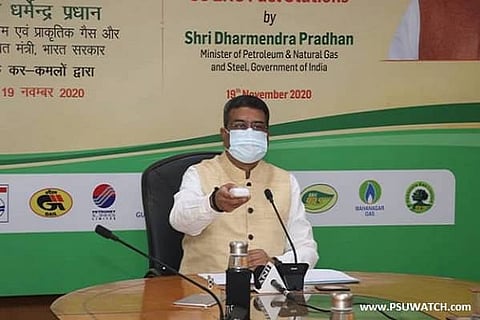
- News Updates
- PSU Watch
- Defence News
- Policy Watch
- हिन्दी न्यूज़
- Jobs Watch
- States News
- Event News

New Delhi: Union Petroleum Minister Dharmendra Pradhan laid the foundation stone for the first 50 LNG fueling stations, across the golden quadrilateral and major national highways on Thursday. These 50 LNG stations will be set up and commissioned in partnership with the country's oil & gas majors such as IOCL, BPCL, HPCL, GAIL, PLL, Gujarat Gas and their joint venture companies and subsidiaries. Out of these 50 LNG stations, IOCL will set up 20 LNG stations, while BPCL and HPCL will set up 11 each LNG station. These 50 LNG stations are being put up at the nation's Golden quadrilateral and major National highways where LNG is to be made available for heavy vehicles and buses.
This is part of a slew of initiatives of the Ministry of Petroleum and Natural Gas in realizing Prime Minister Narendra Modi's vision of transforming India into a gas-based economy. The government has identified LNG as a transport fuel as a priority area considering the potential of manifold benefits in terms of reducing vehicular pollution, saving in terms of import bill of the country, and wide-ranging benefits that may accrue to fleet operators, vehicle manufacturers and other entities in the gas sector.
Speaking on the occasion, Pradhan said that a well-thought strategy is being implemented to take the country towards the gas-based economy. In this regard, gas infrastructure is being set up, in terms of laying of pipelines, setting up of terminals, enhancing gas production, introducing the simple and rational tax structure. He said that LNG is going to be the fuel of the future for transport, and in this regard, retrofitting of the vehicles, as well as development by Original equipment manufacturers, is being undertaken. The Minister said that the LNG is not only almost 40 percent cheaper than diesel but also causes very less pollution. He said that the Government will set up LNG stations at a distance of 200-300 km on the golden quadrilateral, and within three years, we will have 1,000 LNG stations on all major roads, industrial hubs and mining areas. He expressed confidence that 10 percent of the trucks will adopt LNG as fuel.
The 50 LNG stations will be set up and commissioned in partnership with the country's oil & gas majors such as IOCL, BPCL, HPCL, GAIL, PLL, Gujarat Gas and their joint venture companies and subsidiaries. Out of these 50 LNG stations, IOCL will set up 20 LNG stations, while BPCL and HPCL will set up 11 each LNG station
Pradhan further said that the government is working to meet the commitment made by the Prime Minister in COP-21 (The 2015 United Nations Climate Change Conference) to reduce pollution. He said that the government provided eight crore poor households with LPG connections under PMUY, and during the pandemic, 14 crore free cylinders have been distributed to help support PMUY beneficiaries. The Minister said that clean and affordable fuel has become an instrument of the welfare of people. He said that the government will continue to promote CNG vehicles, Electric vehicles, Auto-LPG, but at the same time, LNG as long-haul fuel will be pushed. 20-25 MMSCMD equivalent LNG will come to the country, and cheaper LNG is likely to be available in the global market. He said that increased LNG consumption in the country will reduce the country's dependence on crude oil.
Speaking on the occasion Petroleum Secretary Tarun Kapoor said that the government is making a long-term plan to promote LNG. The first trial of the fuel was started in 2015, and it is now ready to take off on a commercial scale. He expressed confidence that LNG's use will increase and adopted for long haul trucks and buses.
Natural gas, being an environment-friendly clean fossil fuel, has the potential to play a significant role in providing solutions to the environmental challenges as well as ever-growing energy needs in a sustainable manner. Accordingly, the government has focused to promote the usage of natural gas as a fuel/feedstock across the country to increase the share of natural gas in the primary energy mix from the current level of 6.3 percent to 15 percent by 2030.
LNG use in trucks can reduce SOx (sulfur oxides) emissions by 100 percent and NOx (nitrogen oxide) emissions by 85 percent thus befitting society at large. Further, the Heavy Duty vehicle segment is expected to grow significantly with increased highway development which is on-going across the country. LNG-based truck operators can look forward to saving around Rs 2 Lakh per annum per truck which will result in the higher upfront cost of LNG trucks being paid back in around 3 – 4 years. LNG as a heavy vehicle fuel segment can also provide around 20-25 MMSCMD of new gas demand by 2035 and will be an important contribution towards our vision of 15 percent share of Natural Gas in India's energy mix.
(PSU Watch– India's Business News centre that places the spotlight on PSUs, Bureaucracy, Defence and Public Policy is now on Telegram. Join PSU Watch Channel in your Telegram and stay updated)
